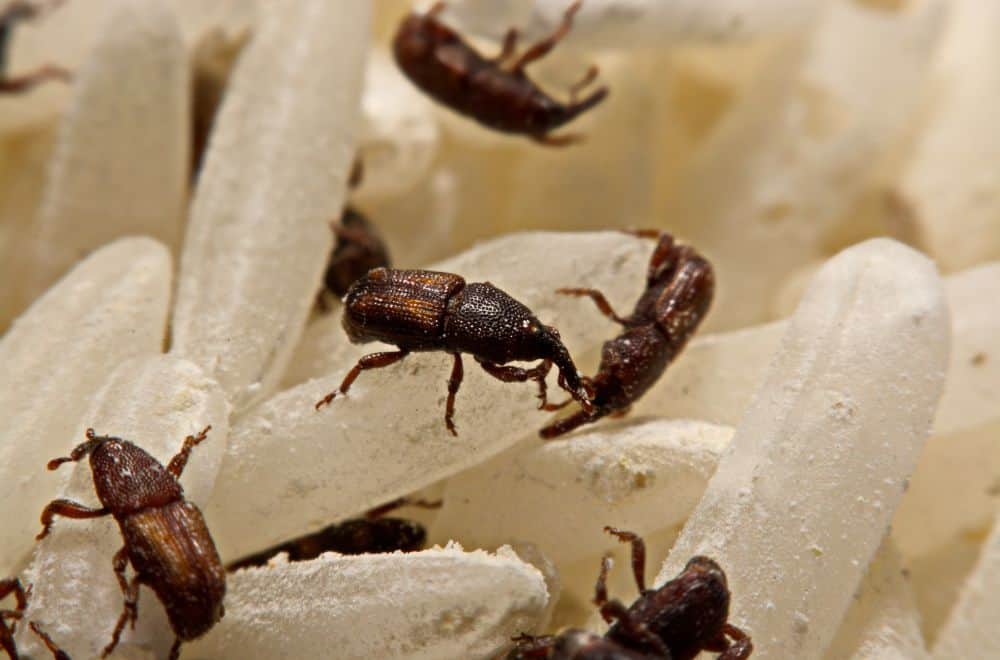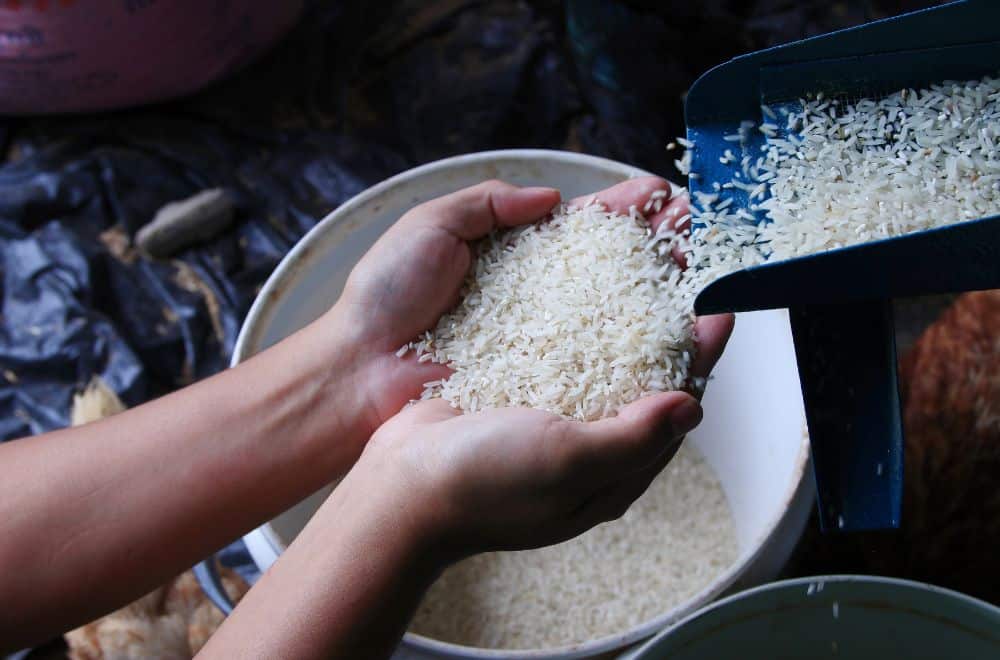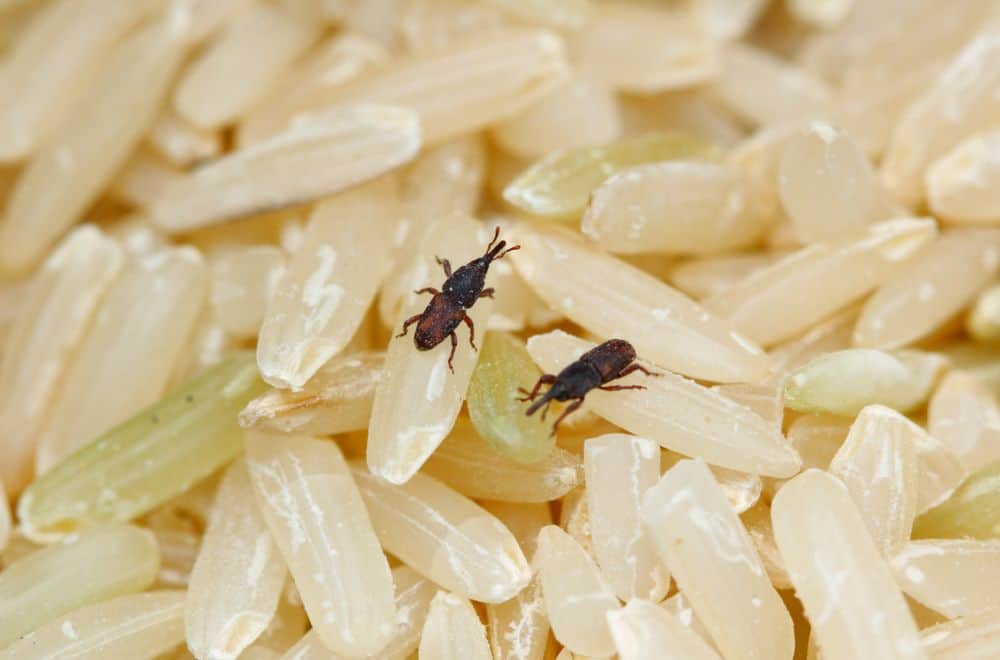Weevils are small bugs with elongated bodies and a streamlined profile. They range from dark brown to black and feed on grains and cereals including rice, maize/corn, legumes, and wheat. Today, we’re going to learn how to get rid of rice weevils once they’re in your pantry.
How to Get Rid of Rice Weevils
How to Identify Rice Weevils
Weevils look similar but are classified by the food they eat. They all have a long snout with antennae on either side. Rice weevils have a reddish-brown body that’s rather dull but stands out against white rice. They’re better camouflaged in yellow, brown, or black rice though. Unlike other weevils, rice weevils can fly, and they have four lighter patches on their wings.
Weevils are typically 2 to 3mm long (1/8 inch) and are classified as beetles, though their bodies are leaner and longer than most of their cousins. Most weevil species have pit-like dimples on the thorax, stripe-like lines on their abdomen, and light-colored spots on their wings so they’re quite stylish when you think about it. But their dull skin tone hides all this.
Weevils have four life stages – egg, larva, pupa, and adult. The larvae have a humpback and no legs. They have off-white bodies and a darker tan head. These larvae dig into seeds and feed on the starch as they grow into pupae and develop a snout. The adults then eat their way out of the grains and bore holes into other seeds, lay eggs, and continue with their life cycle.
The Lifecycle of Rice Weevils

Apart from rice, these weevils can also attack macaroni, barley, oats, wheat, rye, and corn. Of all the weevil species, only maize and rice weevils can fly, so they easily spread within your pantry. A female rice weevil can lay 3 to 4 eggs per day by planting one egg in every hole she digs. And since her lifespan is 3 to 4 months, she can lay 300 or 400 eggs during her lifetime.
The lifecycle of these eggs is about a month. The egg takes 3 days to hatch, its larva stage is 18 days, and its pupa stage lasts 6 days though it can go up to 16. As an adult, the rice weevil stays in the grain of rice for 3 or 4 more days as its exoskeleton hardens, then digs its way out of the seed and starts a new generation. Flying adult rice weevils are attracted to bright light.
Also, they can play possum! When a rice weevil feels threatened, it will fall over, pull its legs close to its body, stop moving, and go completely quiet so that its predators think it’s dead. Rice weevils don’t bite people, cause infections, or spread diseases. But since they hollow out rice, they waste lots of food in paddies and pantries, doing a lot of damage in short periods.
How to Control Rice Weevils
It’s likely that the weevils got into your rice while it was still in the paddy. Adult weevils may have laid their eggs in the grains, and these babies grew and spread all the way to your home. Also, since rice weevils can fly, some may have landed in your bag of rice at the grocery store and gotten a free ride into your pantry. One of the easiest steps to manage them is freezing.
Whenever you bring a bag of rice into the house, freeze it for the first four or five days. That’ll get rid of any eggs, larvae, pupae, or adult weevils. When you take the food out of the freezer, remove it from its original bag and spread it on a well-lit surface. Carefully sort the rice to remove any dead eggs, caterpillars, or bags, then transfer the rice to a different container.
You can use bags, plastic dishes, or bins, but they should be airtight. You can then store them in the pantry, ideally in small portions so they don’t attract any new pests. You can vacuum-seal the portions or freeze them in meal-sized packages. That way, you only take out what you need to cook. Some sources suggest heating the rice instead, in a microwave or oven.
This works because it kills the rice weevils. But because uncooked rice has so little moisture, it may damage your microwave. And if you toast the uncooked rice in a pan or oven, it will affect the cooking process by hardening and browning the outer shell. This alters the taste and texture of the rice when you later boil or steam it, though it’s a common step for pilau.
Use Extreme Temperatures to Manage Weevils

That said, it’s safe to leave uncooked rice in the freezer for months at a time, so that’s your smartest option if you can freeze or vacuum-seal the rice in meal-sized portions. One cup of uncooked rice can comfortably feed two people, so you can calculate storage sizes based on your household population. You should also inspect all your rice before bringing it indoors.
This can be tricky because if you remove it from its original packaging, some of the weevils might escape and attack other grains and nearby food items. So it’s safer to freeze the rice immediately then repackage it later. Meanwhile, you should check your storage areas often and rearrange your storage containers. This will expose any pests that are hidden on shelves.
Vacuum the pantry thoroughly to remove any eggs, debris, or nesting materials that can cause cross-contamination. Keep the area well-lit to avoid hiding spots, and consider using a bug zapper for pests that are attracted to light. But if you look at a bag of rice and it has hundreds of dark bugs crawling through it, dump the whole thing out. It’s unsalvageable!
Be careful how you dispose of it though. You can bury it in a really deep hole where the grains won’t germinate and the bugs won’t crawl to the surface. Or you can triple-seal everything in airtight plastic bags, and toss them in the trash. After all, you don’t want the weevils creeping out of the bag and sneaking into someone else’s cereals. They spread fast!
Storage Options that Keep Rice Weevils Away

Most grain pests can’t dig their way out of paper or plastic bags. But many other insects can. Remember, cockroaches and silverfish feed on paper. And the sharp bits on many grains can poke through plastic, leaving tiny holes that rice weevils can slip through. So avoid keeping your rice in bags. Instead, use airtight jars made of strong plastic, glass, or rust-proof metal.
If you have enough freezer space, your rice should be permanently on ice. Don’t worry, the grains are dried before sale so the freezer won’t change their taste or texture. But if you don’t have consistent electricity, you can still keep your rice safe in airtight bins. It still helps to freeze the rice for a week or two after purchase. Find a friendly freezer for pre-storage prep.
While rice weevils mostly live inside dried grains, they can occasionally hide on shelves. So you should regularly clean your storage area. Wash with food-friendly soap such as dish soap and dry the shelves completely. Vacuum the storage spots to get rid of any hidden eggs, and pay special attention to gaps, cracks, and crevices. Clean and seal these to block entry.
If you have a trash bin in the kitchen, empty it daily, clean it with hot water, then disinfect it. Also, when you’re done with your bags of grain, throw them outside the house so any pests don’t sneak their way back in. Be extra careful when tossing trash or composting, since those bugs can hop onto your hair, shoes, gloves, or clothes and piggyback straight into the house!
Traditional Tactics to Avoid Rice Weevils
Many indigenous communities will manually sort rice before cooking or storing it, so that’s an option you could try. Spread the rice on a shallow plate or wide tray and methodically sift it with your fingers, taking out any stones or insects. It takes a while, but it’s quite effective. You can also place two books of matches in the rice while sorting. The smell repels weevils.
Other traditional tips include slipping neem leaves, bay leaves, cloves, ginger, turmeric, or a bulb of garlic. They must be whole when you stuff them into bags of uncooked rice. Rice weevils and other bugs hate the smell of these herbs and spices so they’ll stay away. It’s safe to cook them with the rice, but you can pick them out before cooking if you dislike the taste.
Also, we earlier mentioned that heat can work, so spread your rice in a thin layer and leave it outside in strong sunlight. This will scare out any adult weevils but won’t bother the eggs, larvae, or pupae that are already inside the grains. And you’ll have to watch the rice closely so that birds and other pests don’t get into it. Later, you can freeze the right in airtight tins.
Use Pesticides Carefully
With certain grains, you can dust them to kill bugs on contact. This doesn’t work for weevils though because the eggs, larvae, and pupae are inside the seed. Plus, the pesticide dust could affect anyone who later eats the grains. Instead, you can clean and spray the empty storage shelves with targeted products. Focus on cracks, corners, edges, and gaps where pests hide.
Do you have any additional advice on how to get rid of rice weevils? Tell us in the comments!
